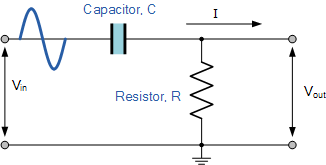Passive Filters
What is the difference between a high-pass and low-pass filter? Give an example of each.

Expand Hint
Electronic filters are a type of signal processing filter that can remove/enhance (or both) frequency components from an applied signal.
A low-pass filter is a circuit that is designed to reshape, attenuate, reject, or modify all unwanted high frequencies from an electrical signal, and only allow a range of lower frequencies to pass through. It is done "passively" through resistors, capacitors, and inductors. Unlike active filters, passive filters do not contain any amplifying elements such as transistors and op-amps to strengthen the signal, meaning the passive filter outputs are always less than the initial input due to the no signal gain. A simple RC low-pass filter diagram is shown below.

A high-pass filter is the exact opposite of a low-pass filter since it attenuates low frequencies, and only passes signals above a predetermined cut off point. Compare the differences in the simple high-pass filter set up below.

Low-pass filters are typically used in subwoofers and other similar speakers to block high notes, beats, and pitches that the hardware/device is poor a producing. Comparatively, tweeters utilize high-pass filters to optimize audio fidelity by blocking bass signals that could damage the speaker hardware.
A low-pass filter is a circuit that is designed to reshape, attenuate, reject, or modify all unwanted high frequencies from an electrical signal, and only allow a range of lower frequencies to pass through. A high-pass filter is the exact opposite of a low-pass filter since it attenuates low frequencies, and only passes signals above a predetermined cut off point. Low-pass filters are typically used in subwoofers and other similar speakers to block high notes, beats, and pitches that the hardware/device is poor a producing. Comparatively, tweeters utilize high-pass filters to optimize audio fidelity by blocking bass signals that could damage the speaker hardware.
Time Analysis
See how quickly you looked at the hint, solution, and answer. This is important for making sure you will finish the FE Exam in time.- Hint: Not clicked
- Solution: Not clicked
- Answer: Not clicked